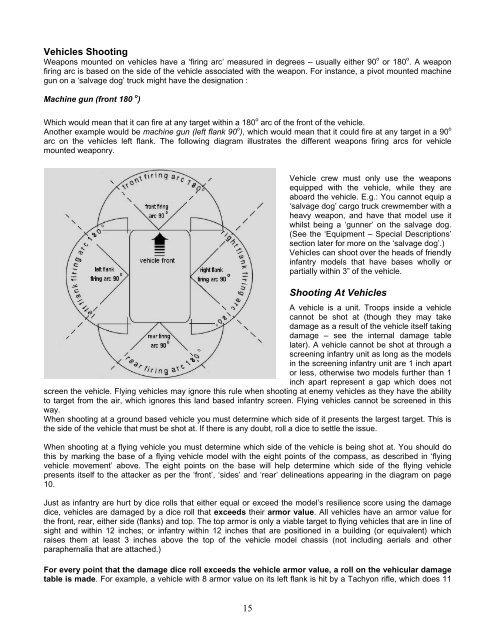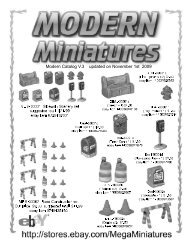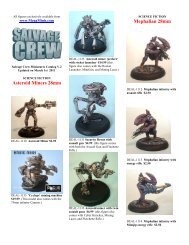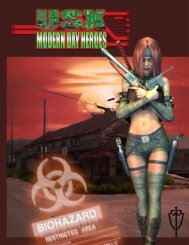still play a part in the battle if there is somebody friendly on the field with the ‘battlefield medic’ skill (or the‘technician’ skill if the victim is a MEKK). Lay the injured figurine on its side until it has been attended to bythe medic/ technician.Humanoid creatures generally have a resilience score of 3.Light armour has a value of 3.Medium armour has a value of 5.Heavy armour, or battle armour may have a value of 7 or more.The target’s total defense score may also be modified by the following types of cover:1. Light cover (hedges, fences, foliage) = +1 or +2 modifier2. Heavy cover (barrels, buildings, walls, rocks) = +3 modifierNote: It is worth using building corners as cover. Even though they are vertical, they can still provideheavy cover for an infantry model. Cover bonuses are not cumulative.Other defense score modifiers may count, such as a BIO having ‘biomechanical implants’ (which give a bonusto resilience).If the target is removed from play in this fashion, they may not necessarily be dead. After the game, the companyboss can roll a recovery/repair roll to see if his recruit recovers. On a roll of 1 – 4 on 1D6 (for BIOS), the targetrecovers and may be used in the next game. On a 5 – 6, he’s dead. If the target is a MEKK, this recovery/repairroll may only be successful on a 1 or 2 on 1D6. This is because although tough and resilient, MEKKs onceknocked out of action will have suffered very heavy damage and probably rendered useless. They do not havethe bio’s ability to self heal. See more on the ‘Recovery/Repair Rolls For Infantry Casualties’ in Chapter 3 - GameMissions.A unit may shoot at an enemy unit that is engaged in melee with a third, friendly unit, but a loyalty test must bemade by the shooting unit in order to do so.Bear in mind that if you shoot at enemy models that are engaged base to base with your own troops, you may hityour own troops and even suffer a drop in company loyalty as a result. Enemy infantry that are shot at whilealready engaged in hand to hand combat may NOT invoke the ‘returning fire’ rule (see below). If you DOshoot at enemy models that are engaged base to base with your own troops, then for every successful hit, roll a1D6 – if the result is a 1 or 2 then you have hit your own crew member, and must then roll the damage dice andresulting effects as if the fire had been made by an enemy. Otherwise the aim is true.The ‘Returning Fire’ RuleWhen a unit is fired upon by another unit, a gun battle may ensue. Any infantry models in a unit, not engagedbase to base in melee, may return fire immediately after any members of their unit are fired upon by anotherunit. At no SP cost.A vehicle unit may return fire immediately after being fired upon by another unit, provided that the unit beingshot at is also within the vehicles ‘firing arc’. However, vehicle mounted ’heavy artillery’ class weapons maynot ‘return fire’ they are too cumbersome to engage in fire-fights.Before a unit can return fire, casualties must be determined for the initial shooting by the antagonistic (first) unit.Only then, if there is anybody left alive, may the targeted unit return fire. Therefore a unit may get to shoot at theWounded/damaged enemy during the enemy’s Infantry phase. models and the ‘Coup de Grace’Any enemy infantry models that come into base to base contact with your wounded/damaged infantry modelsmay When deliver returning a ‘coup fire you de can grace’. shoot Provided at any model you have in the no enemy ‘healthy’ unit infantry that is visible. models within 3” to protect your fallencomrade. For more about wounded models and medics, please refer to the ‘medic’ skill in the ‘crew skills’ sectionlater. Lastly, Wounded if your unit models is returning may be fire shot on at an only enemy on the unit phase that they is partially become engaged ‘wounded’. in melee Wounded with models some of do your not own countas recruits, infantry then screen. your unit must make a loyalty test to do so. However, they may return fire automatically (without aloyalty test) on any models in that enemy unit that are further than 3” from any of your own infantry models.14
Vehicles ShootingWeapons mounted on vehicles have a ‘firing arc’ measured in degrees – usually either 90 o or 180 o . A weaponfiring arc is based on the side of the vehicle associated with the weapon. For instance, a pivot mounted machinegun on a ‘salvage dog’ truck might have the designation :Machine gun (front 180 o )Which would mean that it can fire at any target within a 180 o arc of the front of the vehicle.Another example would be machine gun (left flank 90 o ), which would mean that it could fire at any target in a 90 oarc on the vehicles left flank. The following diagram illustrates the different weapons firing arcs for vehiclemounted weaponry.Vehicle crew must only use the weaponsequipped with the vehicle, while they areaboard the vehicle. E.g.: You cannot equip a‘salvage dog’ cargo truck crewmember with aheavy weapon, and have that model use itwhilst being a ‘gunner’ on the salvage dog.(See the ‘Equipment – Special Descriptions’section later for more on the ‘salvage dog’.)Vehicles can shoot over the heads of friendlyinfantry models that have bases wholly orpartially within 3” of the vehicle.Shooting At VehiclesA vehicle is a unit. Troops inside a vehiclecannot be shot at (though they may takedamage as a result of the vehicle itself takingdamage – see the internal damage tablelater). A vehicle cannot be shot at through ascreening infantry unit as long as the modelsin the screening infantry unit are 1 inch apartor less, otherwise two models further than 1inch apart represent a gap which does notscreen the vehicle. Flying vehicles may ignore this rule when shooting at enemy vehicles as they have the abilityto target from the air, which ignores this land based infantry screen. Flying vehicles cannot be screened in thisway.When shooting at a ground based vehicle you must determine which side of it presents the largest target. This isthe side of the vehicle that must be shot at. If there is any doubt, roll a dice to settle the issue.When shooting at a flying vehicle you must determine which side of the vehicle is being shot at. You should dothis by marking the base of a flying vehicle model with the eight points of the compass, as described in ‘flyingvehicle movement’ above. The eight points on the base will help determine which side of the flying vehiclepresents itself to the attacker as per the ‘front’, ‘sides’ and ‘rear’ delineations appearing in the diagram on page10.Just as infantry are hurt by dice rolls that either equal or exceed the model’s resilience score using the damagedice, vehicles are damaged by a dice roll that exceeds their armor value. All vehicles have an armor value forthe front, rear, either side (flanks) and top. The top armor is only a viable target to flying vehicles that are in line ofsight and within 12 inches; or infantry within 12 inches that are positioned in a building (or equivalent) whichraises them at least 3 inches above the top of the vehicle model chassis (not including aerials and otherparaphernalia that are attached.)For every point that the damage dice roll exceeds the vehicle armor value, a roll on the vehicular damagetable is made. For example, a vehicle with 8 armor value on its left flank is hit by a Tachyon rifle, which does 1115
















